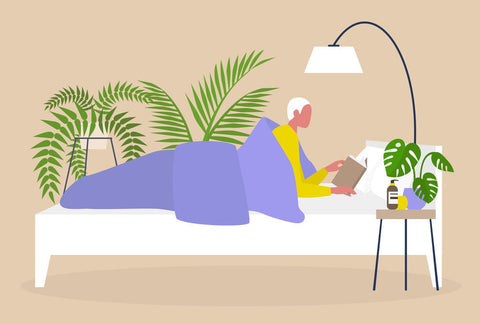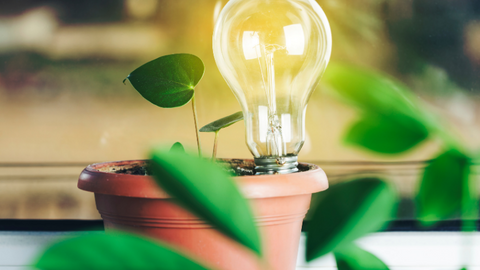The purpose of this blog is to provide a launchpad for you to learn about grow lights, understand your options, and ultimately help you find the right grow light for you (and your plants!).
This blog is the first in our mini-series on Indoor Edible Gardening 101. The remainder of this blog will cover:
-
Looking For The Best Grow Light? A Buyers Guide For Your First Grow Light
-
Grow Lights For Indoor Plants - How To Measure It, and Understanding Watts, PPF, PPFD and DLI
-
LED Grow Light Distance Chart From Plants. How Far Should Grow Lights Be From Plants?
-
Do You Have Enough Light To Grow Plants Indoors? Make A Light Map To Find Out
Why Use A Grow Light?
The main reason to use a grow light is that they allow you to reduce (or eliminate) your dependency on natural light – i.e. sunshine. Light is essential for plant growth, but often (for example indoors, during winter, or in a densely populated urban area) it is in short supply. Grow lights allow us to grow plants in locations, or at times of year, where/when it would otherwise be impossible. Grow lights can be used for seed starting, house plants, herbs, flowers, fruits, vegetables and more.
Can Grow Lights Replace The Sun?
Sunshine is a unique asset, and one that can never truly be replaced – even by the best grow light in the world. However, sunlight serves many purposes – it keeps us warm, it lets you see the lamp pole so you don’t walk into it, and it feeds the photosynthesis process for plants. Some, but not all, of the amenities that sunshine offers are important to plants. Grow lights are in fact capable of providing many of the amenities that plants care about.

Grow Light Quality Perspective
One of the main differences between grow lights and the regular light bulbs you use to illuminate your home is the spectrum of light that they distribute. The human eye can ‘see’ light with frequencies ranging from about 380 (we call it “purple”) to 740 (“red”) nanometers, however we are most sensitive to yellow light, and therefore the cheapest and easiest way for us to illuminate our homes is to provide us with yellow light.
Although plants can and do appreciate light from across (and even beyond) the visible spectrum, it is the red and blue frequencies of light that are most important to them. This is why you will find many grow lights online that look purple – being a combination of red and blue. Personally, we don’t really like these purple grow lights. Sure, they’re efficient from an energy perspective, but they also omit other frequencies such as UV, IR, greens and yellows. Granted, none of these are as critical as red and blue, however these other frequencies offer a myriad of plant health benefits which are still the subject of much research and learning within the scientific community. UV, IR, greens and yellows can impact things like disease and pest resistance, thickness and texture of leaves, as well as the taste, flavor and oils that a plant produces.
Although the ‘best’ frequencies of light for plants is still a hotly debated topic, the reality is that yes – grow lights are able to provide a suitable substitute to natural light from a light quality perspective.
Grow Light Intensity Perspective
One of the biggest challenges us humans face in evaluating and understanding light is our pupils. Those things in the front of your eyeball that expand and contract to let varying amounts of light onto your retina. The role of our pupils is to regulate the amount of light that comes into our eyes – when light is abundant these holes are small. When its scarce they open up to let more light in. What this means is that we spend our entire life walking around with automatic light adjusters influencing how we see the world – and in the most part, we are completely oblivious to these adjustments that are constantly being made. It also means that we are really really bad at evaluating the intensity of light.
For this reason, us humans have to rely on tools (that don’t have pupils) to measure light for us. Photographers typically measure light in ‘Lumens’ or ‘Lux’, and in the plant world we focus on a slightly different unit of measure called ‘PAR” – or ‘photosynthetically active radiation’. To learn more about PAR and how we measure and quantify light for plants we recommend Grow Lights For Indoor Plants – How To Measure It, and Understanding Watts, PAR and DLI.
Although modern grow lights are capable of delivering light in sufficient quantities for your plants, the truth is that not all of them do. Meeting the light-intensity needs of slow-growing decorative plants such as monstera, pothos or snake plants is relatively easy – even with a cheap or effective grow light at further spacing. However edible plants grow faster, and more rapid growth rates require more energy (think of them like teenagers). Getting a sufficient intensity of light for edible plants generally requires a better quality or higher power grow light, as well as have it properly distanced from your plant. To learn more about grow light placement and setting them at the right distance we recommend ‘Setup and Placement of Grow Lights For Plants – How To Get The Distance Right?’

Economical Perspective on Grow Lights
Grow lights have been around for decades, and for a long time they have been capable of providing both the quality and quantity of light that plants need to grow. However, it hasn’t been until the past decade or so that they have become efficient enough that their cost of ownership is now low enough that they can offer an economical alternative to natural light for farmers, or growing food. Put another way; what that means is that the cost of running a grow light is now less than the value of the food we can grow underneath it. This wasn’t always the case, but is the reason why you’ve been hearing a lot more about indoor and vertical farming over the past 5 years or so. Grow light technology is the primary ‘enabler’ of this now booming industry.
What Grow Lights Are The Best?
Wanting to know what grow light is best for you is a common question, with a simple answer: “it depends” (sorry!!) Fortunately we have an entire mini-series of blogs and videos to help you out, but in order to get a good answer to this question we need to think about:
- What is your budget? Do you want to spend $20 or $2000?
- Where do you want to place it? In a hydroponic grow tent in your basement, or on your kitchen counter?
- What do you want to grow? Are we thinking tomatoes or succulents here?
- How much / many do you want to grow? An urban jungle, or just a single basil plant?
Here at Urban Leaf our focus is on edible plants – including herbs, fruits, vegetables and microgreens. Edible plants typically (there are exceptions, eg microgreens) have much higher light requirements than decorative houseplants, so our bias is towards higher quality or at least higher power grow lights rather than weaker ones.
Our mission is to encourage people to get to know their plants and how to grow them too, so we encourage keeping plants in the places where you spend the most time – such as your kitchen or living room. For this reason, we care a lot about their color (another reason we don’t like purple ones) and the way that they distribute the light.
And finally our focus is on helping people who want to maintain small gardens consisting of 1 – 10 plants in their home, and for this reason we feel that LED grow lights offer the most attractive combination of affordability, flexibility of arrangement, and energy usage.
What’s best for us may not be best for you, however. If you’d like some help with finding the right grow light for your own situation, we recommend ‘Growing Plants Under Lights: A Guide To Buying Your First Grow Light’.
How To Use A Grow Light With Your Plants?
Grow lights vary tremendously in terms of the amount of Plant Available Radiation (PAR) that they emit. At the same time, plants vary greatly in terms of the amount of light they need. There are two main variables you need to consider, and are typically able to adjust, when it comes to grow lights however – they are distance and duration.
Grow Light Distance To Plants
Light degrades VERY quickly with distance. In fact, a ‘point’ source of light follows what is known as an ‘inverse-square law’. What that means is that every time you double the distance from a light, the intensity reduces by a factor of 1/4th. So a PAR value of 400 umol/m2/s at say 4” (or 10cm) from a grow light could be adequate for your basil plant, but when you move that grow light to be 8” (20 cm) away from the plant, the PAR value would fall to roughly 100umol/m2/s, which is likely too low.
Now there are ways that the impact of this inverse square law can be offset – most commonly this is done with lenses or optics that attempt to ‘channel’ the light in the direction of the plant. Although these are helpful, and give you more flexibility in terms of plant placement relative to your light, the fact remains that the right distance between plant and light will depend on the intensity of the light and the light requirements of the plant – and could be anyway from 2” (5cm) to 6’ (1.8 meters).
To learn more about grow light placement, refer to How Far Should Grow Lights Be From Plants?
How Long Should A Grow Light Be On For?
This question is a little easier to answer than the topic of distance, but can still vary a lot. In ‘Grow Lights For Indoor Plants – How To Measure It, and Understanding Watts, PAR and DLI’ (coming soon) we discuss light measurement for plants and Daily Light Interval (or ‘DLI’). But for the purposes of this introduction to the concept, plants’ light requirements are measured as a ‘volume’ called DLI, which is equal to the rate of flow (measured in PAR) multiplied by duration. So a 400umol/m2/s light source operating for 10 hours a day would deliver the same amount of DLI as a 800umol/m2/s light source operating for 5 hours a day. Both give a DLI of 4000.
Generally speaking, the right answer for grow light timing is going to be between 8 – 16hours, and you should probably pick a timing that suits your lifestyle and its placement. You probably don’t want a grow light on for 16hrs if it’s in a bedroom, for example, and 8 hrs might be too short if you’re counting on this light being a centerpiece or feature of your living space. Keep in mind though that delivering the same amount of DLI in a shorter amount of time requires a higher light intensity. That (likely) means a more expensive light. Plus, if the intensity gets too high, you risk burning your plant from too much light – all plants have a finite limit to the rate at which they can absorb light comfortably, and if you exceed this you will either damage or even kill them. At the other end of the duration spectrum, remember that plants (like us) do need to ‘sleep’. They have whats called a photorespiration period. In fact, for many plants a period of darkness is essential to flowering or fruiting.
Are Grow Lights Safe?
Like many things, grow lights are safe so long as they are used responsibly. As long as you apply common sense then you, your pets, and your home are likely to remain safe.
Some common dangers to be aware of in relation to grow lights include:
- Grow lights are bright. Just like you shouldn’t look straight into the sun, we don’t recommend looking straight into grow lights either.
- Grow lights can emit heat. This is less of an issue for LED lights (which we recommend for small-scale hobbyists) but other types of grow lights such as HPS do get very hot and can burn.
- Grow lights are electrical appliances. Generally speaking LED grow lights don’t use huge amounts of electricity, and if you’re only using 1-2 small ones you won’t have much to worry about, but if you start using larger sized versions or a greater quantity of any electrical appliance the current they will draw does increase. Make sure you understand concepts like watts and amps (discussed in ‘Grow Lights For Indoor Plants – How To Measure It, and Understanding Watts, PAR and DLI’) if you are planning a bigger setup, as you will need to make sure that your power boards, cables, and electrical system are able to handle it.
- Although it is uncommon in consumer grow lights, some do emit UV or ultraviolet light. UV light is just beyond purple in the visible light spectrum, and in high doses can damage human skin – just like UV from the sun can. That said, the UV that grow lights emit is both rare, and when it is present the quantities are fairly benign relative to what you would encounter when you go outside from the sun.
To learn more about grow light safety check out ‘Are Grow Lights Safe?’ (coming soon).

Are You Sure You Actually Need A Grow Light?
If you’re confident that you need a grow light then you’re in the right place – our mini-series on grow lights as part of the Indoor Edible Gardening 101 Series contains all the information you need to understand these products and select the right one for you.
That said, if you can get away with only using natural light, why wouldn’t you? It’s cheaper to install and costs nothing to run! If you’re still not sure about whether you even need a grow light, then we recommend checking out ‘Understanding Your Natural Light Environment – What Plants Can You Grow?’ (coming soon) and ‘4 Easy Tricks To Increase Your Light For Plants That May Save You From Buying A Grow Light’.
We hope you’ve found this introduction to grow lights useful. If you still have unanswered questions, please leave them below – we check comments daily. If you’ve found this information useful, then all we ask is that you share it with a friend! Our goal at Urban Leaf is to make Indoor Edible Gardening easy and accessible, so if you think this blog could help just one extra person get started with growing their own food then it’s a win for us, and a win for the planet, so we’d be grateful if you could help us spread the word.
If you’d like to learn more about how to grow your own food, be sure to sign up to our email list below for regular content, ideas, and the occasional special deal on gardening products.









There are no comments for this article. Be the first one to leave a message!